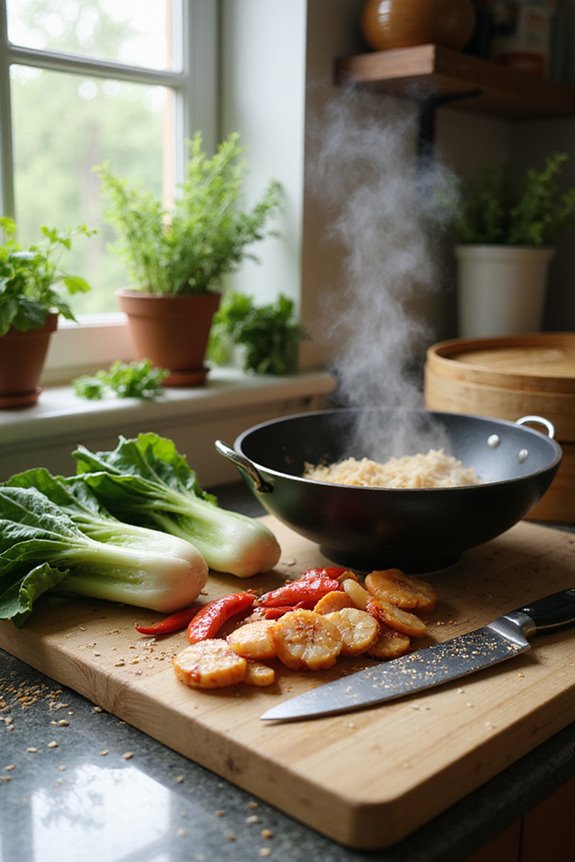As an Amazon Associate, we earn from qualifying purchases. Some links may be affiliate links at no extra cost to you. Although our opinions are based on curated research, we haven't used these products. Articles generated with AI.

5 Best Miso Paste Collections to Elevate Your Culinary Creations
To elevate your culinary creations, consider these five top miso paste collections: Miko Brand’s Freeze Dried Variety Pack offers convenient flavors; Muso From Japan’s Smart Miso delivers a sweet umami kick. MARUKOME’s Original Miso provides an all-natural broth concentrate, while Roland Foods’ White Miso Paste brings a mild taste for sauces and soups. Finally, Miko Brand’s Miso Soup 20 Piece Value Pack features authentic flavors ready in under a minute. Stick around to explore factors for choosing the right collection!
Key Takeaways
- Miko Brand Freeze Dried Variety Pack offers rich flavors and quick preparation, perfect for busy schedules and flavorful soups.
- Muso From Japan’s Smart Miso delivers a deep umami flavor, ideal for special occasions and a variety of dishes.
- MARUKOME Original Miso concentrate provides a health-conscious option with all-natural ingredients for enhancing various recipes with minimal effort.
- Roland Foods White Miso Paste features a mild flavor great for sauces and marinades, although it has a higher sodium content.
- Miko Brand Miso Soup Value Pack allows customization with additional veggies and offers authentic flavors in a quick-to-prepare format.
Miko Brand Freeze Dried Variety Pack Miso Soup 10 Servings
Miko Brand Freeze Dried Variety Pack Miso Soup 10 Servings
- Each package containes 10 Servings, Two Servings Each of Fried Bean Curd, Green Onion, Vegetable, Fried Eggplant and Tofu
- All Items Are Freeze Dried. You just add Water
- Add 160ml of Hot Water, Stir and Ready To Enjoy
If you’re seeking a quick and satisfying meal option, the Miko Brand Freeze Dried Variety Pack Miso Soup is perfect for you. With 10 servings, you get two each of Fried Bean Curd, Green Onion, Vegetable, Fried Eggplant, and Tofu. Just add 160ml of hot water, and your tasty soup is ready in moments. This miso soup stands out for its delicious flavor, often compared to restaurant-quality, featuring more veggies than typical restaurant servings. While it’s convenient, be aware of safety concerns regarding production in China. Despite this, many customers prefer Miko for its rich taste and hearty ingredients.
Best For: Those seeking a quick, flavorful meal option that is easy to prepare and enjoy, particularly fans of miso soup.
Pros:
- Convenient preparation with just the addition of hot water, ready in moments.
- Tasty flavor comparable to restaurant quality, with generous vegetable portions.
- Well-received by customers, often preferred over more expensive brands.
Cons:
- Production in China raises safety concerns regarding potential contaminants like cadmium.
- Some customers prefer miso products made in Japan due to perceived safety and quality differences.
- Limited serving variety may not cater to all individual tastes.
Muso From Japan Smart Miso, Light Sweet, 5.2 oz
Muso From Japan Smart Miso, Light Sweet, 5.2 oz
- Muso From Japan Smart Miso Light Sweet Miso, Gluten Free, 5.2 Ounce (Pack of 6)
For those seeking a versatile and easy-to-use ingredient, Muso From Japan Smart Miso Light Sweet is an excellent choice. This gluten-free miso combines authentic ingredients like whole soybeans and sweet potato syrup, delivering a deep umami flavor with a touch of sweetness. You can easily incorporate it into miso soup, grilled fish, or even miso butter corn. While some users find it concentrated and salty, adjusting the amount used can help balance its flavor. Its sturdy packaging makes it suitable for outdoor outings too. However, consider it for special occasions due to its higher price per ounce.
Best For: Those looking for a premium, gluten-free miso option to enhance their culinary creations with a rich umami flavor.
Pros:
- Made with authentic ingredients, providing a deep umami flavor and slight sweetness.
- Versatile for various dishes like miso soup, grilled fish, and miso butter corn.
- Sturdy packaging makes it suitable for outdoor use, like camping.
Cons:
- Higher price per ounce, making it less ideal for daily use.
- Some users find it concentrated and salty; may require adjustments for optimal flavor.
- Lacks strong flavor unless a full packet is utilized, which can affect taste in lighter dishes.
MARUKOME Original Miso, 13.8 OZ
MARUKOME Original Miso, 13.8 OZ
- All-natural authentic recipe
- One 13.8 ounce bottle of Marukome miso & easy original miso broth concentrate
- Recipe contains no msg
Marukome Original Miso, a 13.8-ounce miso broth concentrate, is ideal for anyone seeking a quick and authentic way to enhance their culinary creations. This all-natural miso provides a rich flavor without any added MSG, making it a healthy choice for your dishes. Just shake the bottle well before use to guarantee the ingredients mix properly. With approximately 24 servings per bottle, you’ll have plenty to experiment with. Use it as a flavorful broth base for soups, sauces, or marinades. It’s easy to incorporate into your cooking routine, transforming simple meals into delightful Japanese-inspired dishes effortlessly.
Best For: Those looking for a quick and authentic way to enhance their cooking with a healthy miso broth concentrate.
Pros:
- All-natural ingredients without any added MSG for a healthier option.
- Convenient 24 servings per bottle allows for versatile usage in various dishes.
- Easy to use as a broth concentrate, perfect for busy cooks.
Cons:
- Limited to being a broth concentrate, which may not satisfy those looking for more complex seasonings.
- Might not appeal to those who prefer homemade miso or traditional preparation methods.
- Requires shaking well before use, which may be inconvenient for some users.
Roland Foods White Miso Paste, Specialty Imported Food, 35.2-Ounce Package
Roland Foods White Miso Paste, Specialty Imported Food, 35.2-Ounce Package
- WHITE MISO PASTE: Great in soups, marinades, dressings, and spreads
- SWEET AND SALTY: Mild white miso made from fermented soybeans with sweet overtones and a slight saltiness
- SIMPLE PREPARATION: Add a few tablespoons of the miso paste to hot water, dissolve, and use in your recipe
Roland Foods White Miso Paste is an excellent choice for both home cooks and professional chefs who appreciate high-quality ingredients. Imported from Japan, this 35.2-ounce package delivers a mild flavor with sweet overtones and slight saltiness. It’s perfect for enhancing sauces, soups, marinades, and dressings. For the best results, try adding it to long-simmered dishes near the end of cooking to retain its active bacteria cultures. While it has a higher sodium content than some competitors, its smooth texture and flavor consistency make it a pantry staple. Store it wisely to guarantee its freshness lasts for months.
Best For: Home cooks and professional chefs seeking a high-quality, versatile miso paste to enhance their culinary creations.
Pros:
- Restaurant-quality flavor with mild sweetness and slight saltiness ideal for a variety of dishes.
- High versatility suitable for soups, marinades, dressings, and spreads.
- Long shelf life when stored properly, allowing for extended use.
Cons:
- Higher sodium content compared to some other brands, which may be a concern for those on low-sodium diets.
- Packaging lacks resealable features, which could affect moisture retention.
- Taste may be too mild for those seeking a stronger miso flavor profile.
Miko Brand Miso Soup 20 Piece Value Pack, Awase, 11.36 Ounce (Pack of 1)
Miko Brand Miso Soup 20 Piece Value Pack, Awase, 11.36 Ounce (Pack of 1)
- 20 servings per Package
- 5 assorted: (4)Tofu, (4) Wakeme, (4) Green Onion, (4) Spinach, and (4) Fried Bean Curd
- Quick and easy
The Miko Brand Miso Soup 20 Piece Value Pack is an excellent choice for busy individuals seeking a quick yet flavorful meal option. With 20 servings, this pack features five tasty flavors, including Tofu, Wakame, Green Onion, Spinach, and Fried Bean Curd. Made with fresh miso paste and three types of dashi, you’ll enjoy authentic flavors reminiscent of restaurant-quality soup. Preparation is a breeze—just add hot water and enjoy in under a minute. Ideal for quick meals or snacks, it’s a great pantry staple. Plus, you can customize it with veggies to suit your taste preferences!
Best For: Busy individuals seeking a quick, flavorful meal option that’s easy to prepare and customizable.
Pros:
- Quick and easy preparation, ready in under a minute.
- Variety of flavors keeps meals interesting and enjoyable.
- Affordable and provides excellent value with 20 servings per pack.
Cons:
- Some users may find the soup too salty if not diluted with enough water.
- Nutritional aspects may not be satisfactory for health-conscious consumers.
- Flavor intensity can vary between individuals’ preferences.
Factors to Consider When Choosing Miso Paste Collection Variety.

When you’re selecting a miso paste collection, it’s vital to take into account a few key factors. Think about the flavor profiles that appeal to you, as different types offer unique tastes. Also, evaluate the ingredients’ quality, preparation methods, and nutritional values to guarantee you get the best option for your needs.
Flavor Profile Variations
Understanding the flavor profile variations of miso paste is essential for making the right choice in your cooking. For instance, white miso offers a mild sweetness and light saltiness, while red miso delivers a stronger, saltier umami punch. Some varieties, enhanced with ingredients like sweet potato syrup, can elevate sweetness, creating a distinctive flavor balance. Be mindful that concentrated miso pastes may require more quantity to achieve the desired intensity, whereas lighter options suit delicate dishes. Additionally, certain miso types feature regional ingredients and unique fermentation methods, influencing their taste further. This diversity can dictate culinary versatility, as some miso pastes work better for soups and marinades, while others shine in seasoning or enhancing your meals.
Ingredients and Quality
Choosing the right miso paste for your collection goes beyond simply picking a flavor; it involves examining the ingredients and the overall quality of the product. Start by checking the ingredient list—higher quality miso typically contains fewer additives and focuses on natural components like whole soybeans and rice. Know that white miso is milder and sweeter due to its higher rice content, while red miso offers a richer, saltier flavor from longer fermentation. Verify the miso is free from artificial preservatives and MSG for a genuine taste. Also, be aware of sodium content, especially if you’re mindful of salt intake. Finally, look for miso containing active bacteria cultures, as these contribute to its health benefits.
Preparation and Convenience
Considering how you plan to use miso paste can greatly influence your selection for a collection. If you want quick and easy meal prep, look for miso products that require minimal preparation—often just mixing with hot water for a flavorful broth. Various miso concentrations can affect your cooking time, as some may need dilution or extra ingredients to reach your desired flavor. Versatile options that fit various culinary applications—like soups, marinades, or dressings—allow for diverse meals with little effort. Additionally, if you’re an outdoor enthusiast, choose miso designed for easy use in camping situations, ensuring you can whip up delicious meals even without a full kitchen setup. This convenience truly enhances your cooking experience.
Packaging and Storage
When selecting a miso paste collection, packaging and storage should be high on your list of priorities, especially if you want to maximize freshness and longevity. Look for miso paste in resealable containers; they help maintain moisture and extend shelf life. Store your miso in a cool, dry place, and remember that opened jars can last over six months in the refrigerator. If you split your miso into portions, consider keeping one in the fridge and another in the freezer to preserve usability. Also, pay attention to packaging materials; sturdy containers protect your miso during transport and prevent exposure to elements that could compromise quality. Investing in the right packaging will make all the difference for your culinary adventures.
Nutritional Values
Selecting the right miso paste collection involves more than just taste; nutritional values play an important role in your decision. Miso paste can contain a moderate amount of sodium—some varieties pack up to 740 mg per tablespoon—so check the labels to manage your sodium intake. Generally, each tablespoon offers around 35 calories, 2 grams of protein, and 4 grams of carbohydrates. If you’re gluten-sensitive, opt for gluten-free options that may include sweet potato syrup or sugar cane alcohol, affecting flavor and sweetness. Miso’s fermentation process contributes beneficial probiotics, promoting gut health; just be sure to add it at the end of cooking. Finally, miso provides essential nutrients like manganese, vitamin K, and copper, which vary by type.
Culinary Versatility
Miso paste isn’t just a staple of Japanese cuisine; it’s a versatile ingredient that can enhance countless dishes across various culinary traditions. You can use miso in soups, marinades, dressings, and spreads, adding depth to flavors in both traditional and modern recipes. Each type of miso—white, red, or awase—offers distinct profiles, ranging from sweet and mild to rich and savory, which broadens your cooking options. Its concentrated nature allows you to easily adjust quantities to fit everyday meals or special occasions. Plus, miso pairs wonderfully with vegetables, grains, and proteins, enabling you to customize dishes and experiment across diverse cooking styles. Embrace miso’s versatility and elevate your culinary creations with imaginative uses.
Price and Value
Choosing the right miso paste collection hinges on understanding price and value, particularly when it comes to how often you’ll use it. Start by evaluating the price per ounce, as some options may seem pricey for daily cooking. Larger packs typically offer better value, reducing the cost per serving compared to smaller containers. Quality matters, too—premium brands often cost more but can enhance flavor and authenticity. If you frequently enjoy miso soup, a larger, economical pack might be your best bet. Additionally, consider looking for sales or bulk-buy deals; these can lead to significant savings over time, allowing your culinary creations to shine without breaking the bank.
Brand Reputation
Reputation plays an essential role in the world of culinary ingredients, particularly when exploring miso paste collections. Look for well-established brands; their history often indicates reliable quality developed through years of consumer trust. Pay attention to consumer reviews and ratings, as they reveal insights into taste, quality, and overall satisfaction. A brand’s transparency about sourcing and production practices can also enhance its credibility, especially if they emphasize traditional techniques and high-quality ingredients. Endorsements from professional chefs or culinary experts can provide additional validation in your selection. Finally, check for awards or certifications, like organic or gluten-free labels, which showcase a brand’s commitment to quality and safety, influencing your purchasing decisions considerably.
Frequently Asked Questions
What Dishes Can I Make Using Miso Paste?
Using miso paste is like adding a secret ingredient that transforms your dishes into something extraordinary. You can make rich miso soup, energizing noodle bowls, and savory marinades for meats or tofu. It also works wonders in salad dressings, giving them a creamy, umami kick. Try miso-glazed vegetables or incorporate it into sauces for a delightful depth of flavor. Experimenting with miso opens endless culinary possibilities; you’ll soon crave its umami goodness.
How Should I Store Leftover Miso Paste?
To store leftover miso paste, keep it in an airtight container, sealing it tightly to prevent moisture and air exposure. Place it in the refrigerator, where it can last for several months. If you want extra freshness, cover the surface with a thin layer of vegetable oil before sealing. Avoid using wet utensils to scoop out the paste, as this can introduce bacteria and spoil the remaining miso quicker than you’d like.
Is Miso Paste Gluten-Free?
While you might think all miso paste is gluten-free, that’s not always the case. Some types, especially those made with barley, contain gluten. If you want a gluten-free option, look for miso labeled as “rice” or “soybean,” as these are typically safer choices. Always double-check the ingredient list to avoid any surprises. By being mindful of your selections, you can enjoy miso paste without worrying about gluten sneaking into your meals.
Can I Substitute Miso Paste in Recipes?
Yes, you can substitute miso paste in recipes, but it depends on what you’re making. If you need a salty, umami flavor, consider using tahini or a mix of soy sauce and nut butter. For lighter dishes, you might try vegetable broth combined with a bit of soy sauce. Just remember, these substitutes can alter the final taste, so adjust quantities gradually to achieve the desired flavor profile without overwhelming the dish.
How Long Does Miso Paste Last After Opening?
Once you’ve opened miso paste, it typically lasts about three months in the fridge. To keep its flavor intact, store it in an airtight container and guarantee it’s tightly sealed after each use. You might notice color changes or slight aroma shifts, but as long as there are no signs of mold, it’s usually still good. Always taste a small amount to assess quality before using it in your dishes.









